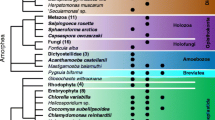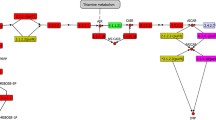Abstract.
Forty-four sequences of ornithine carbamoyltransferases (OTCases) and 33 sequences of aspartate carbamoyltransferases (ATCases) representing the three domains of life were multiply aligned and a phylogenetic tree was inferred from this multiple alignment. The global topology of the composite rooted tree (each enzyme family being used as an outgroup to root the other one) suggests that present-day genes are derived from paralogous ancestral genes which were already of the same size and argues against a mechanism of fusion of independent modules. A closer observation of the detailed topology shows that this tree could not be used to assess the actual order of organismal descent. Indeed, this tree displays a complex topology for many prokaryotic sequences, with polyphyly for Bacteria in both enzyme trees and for the Archaea in the OTCase tree. Moreover, representatives of the two prokaryotic Domains are found to be interspersed in various combinations in both enzyme trees. This complexity may be explained by assuming the occurrence of two subfamilies in the OTCase tree (OTC α and OTC β) and two other ones in the ATCase tree (ATC I and ATC II). These subfamilies could have arisen from duplication and selective losses of some differentiated copies during the successive speciations. We suggest that Archaea and Eukaryotes share a common ancestor in which the ancestral copies giving the present-day ATC II/OTC β combinations were present, whereas Bacteria comprise two classes: one containing the ATC II/OTC α combination and the other harboring the ATC I/OTC β combination. Moreover, multiple horizontal gene transfers could have occurred rather recently amongst prokaryotes. Whichever the actual history of carbamoyltransferases, our data suggest that the last common ancestor to all extant life possessed differentiated copies of genes coding for both carbamoyltransferases, indicating it as a rather sophisticated organism.
Similar content being viewed by others
Author information
Authors and Affiliations
Rights and permissions
About this article
Cite this article
Labedan, B., Boyen, A., Baetens, M. et al. The Evolutionary History of Carbamoyltransferases: A Complex Set of Paralogous Genes Was Already Present in the Last Universal Common Ancestor. J Mol Evol 49, 461–473 (1999). https://doi.org/10.1007/PL00006569
Issue Date:
DOI: https://doi.org/10.1007/PL00006569




